THE SCIENTIST AND THE UFO
Frank B. Salisbury
Utah State University
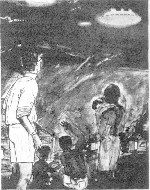
|
1. Biography 2. Prepared Statement |
|
BACK to Contents
|
B.S. University of Utah 1951; M.A. Utah 1962; Ph.D. California Institute of Technology 1955.*
Army Air Force 1945.
Field is plant physiology.
Assistant Professor of Botany, Pomona College 1954-5.
Assistant Professor of Botany, Colorado State 1955-61.
Full Professor, Colorado State 1961-66.
Professor and Head, Dept. of Plant Science, Utah State University 1966-.
Member: AAAS; Society of Plant Physiology; Ecological Society; Astronautical Society.
Interests: Physiology of flowering; space biology; physiological ecology.
THE SCIENTIST AND THE UFOFrank B. Salisbury
|

|
* |
What is the significance of these strange, typically aerial phenomena? There are many extremely important implications in the area of psychology. Perhaps the most obvious is the possibility that the UFO's may be purely psychological phenomena such as hallucinations. Of much greater importance, however, could be the psychological questions of interpretation. These are valid regardless of what elicits the response in the witness -- a real spaceship from Mars or a spotlight shining on a gossamer cloud.
The number of witnesses to these phenomena has increased tremendously in recent years (probably a sizable fraction of 1% of the world's population has been involved in "good" sightings), therefore the phenomenon is of obvious sociological importance. It could influence the relationships between nations or programs of space exploration. It might even, given the proper circumstances, develop into a panic of severe proportions. There is ample justification from the sociological standpoint for a detailed study of the UFO phenomenon.
My interest developed from the field of exobiology. If the UFO's are extraterrestrial spaceships guided by intelligent beings (as many of their witnesses insist), then they are of the most pressing interest to the exobiologist. Current speculation about life on Mars (Jackson and Moore, 1965; Salisbury, 1962, 1966) would be naive indeed if such were the case. Although they would have virtually no significance to exobiology if they are not extraterrestrial, the possibility that they might be seems great enough to merit at least a preliminary investigation.
We might well consider the UFO's from the standpoint of the philosophy of scientific method. Even if the scientific community at large were sincerely interested in the study of the phenomena, it would encounter many difficulties in knowing what approach to take. UFO sightings are events which usually cannot be repeated. The astronomer may also witness such events, e.g., the flares on Mars (Salisbury, 1962; Ley, Willy and Werner Von Braun, 1960), but at least he is a trained observer, and none of his colleagues are likely to doubt his word. In the case of the UFO's, although many observers may be highly trained in certain aspects of contemporary modern life, few, if any, could claim much competence as carefully schooled UFO observers! Frequently, they are not trained to differentiate between observation and interpretation, and often there is a strong tendency for all but close friends to doubt their word. Here, then, is a phenomenon of nature which could, and should, be of extreme interest to the scientist. But it is a difficult one for even him to study. How do we study events which cannot be repeated and which are recorded only through the minds of observers who can scarcely resist the temptation to enlarge their stories and to intermingle the facts with their own interpretations and psychological responses?
One obvious approach is to propose as many possible interpretations as can be devised and then to evaluate the data in terms of these hypotheses. The process will be a circular one, in which hypotheses are formulated on the basis of the data, and the data are then re-examined in terms of the hypotheses. In the following paragraphs, five hypotheses are discussed and then a few representative sightings are considered. The subject has been reviewed by several authors in book form, often competently, but virtually always with some degree of prejudice (for: Hall, 1964; Keyhoe, 1960; Lorenzen, 1962, 1966; Michel, 1958; Vallee, 1965; Vallee and Vallee, 1966 -- against: Menzel and Boyd, 1963).
Can we eliminate the spaceship hypothesis in any rigorous scientific manner? Logically one might think of two approaches: either we must show in each and every instance ever reported that the object was not an extraterrestrial spaceship, or we must show by some sort of scientific logic that it is impossible for extraterrestrial beings to visit us.
Obviously, we cannot show in every case that a purported UFO was not an extraterrestrial spaceship. The data may not be available, and the events cannot be repeated. Furthermore, in several instances, very detailed data do exist in relation to a sighting, and yet it cannot be rigorously stated that the UFO was not an extraterrestrial machine.
Nevertheless, this approach has been followed in an attempt to eliminate this hypothesis, notably by Professor Donald Menzel, Director of the Harvard Observatory (Menzel and Boyd, 1963) and by the United States Air Force. Menzel is aware of the logical limitations, but he takes a statistical approach. He reasons that since many sightings can be positively eliminated as extraterrestrial spaceships, those which cannot could be if only more data were available. This is an excellent example of the inductive form of reasoning which has been so productive in science. Can we confidently apply it in relation to the UFO phenomena? To do so, the cases for which ample data exist and which prove not to be spaceships must be representative of the class as a whole. To many of us this seems unlikely, since other cases fortified with considerable data cannot be eliminated as extraterrestrial machines, and in many ways they appear to have little in common with the cases which can. On purely formal grounds, then, we cannot be absolutely convinced by Menzel's approach.
It is also logically unreasonable to say with absolute certainty that it is impossible for extraterrestrial beings to visit us. Although we know a great deal about the universe, we do not yet know enough to make such an all-inclusive negative statement. Nevertheless, many of the arguments are highly compelling, and two are especially worthy of our attention. The first argument is that the UFO's contravene the laws of nature, or more properly, that they are contrary to our experience. It is first assumed that they could not originate within our solar system because only the earth harbors intelligent life, and then it is reasoned that because of the extreme distances between stars they could not be visitors from some other planetary system. My initial contact with the UFO problem came because of my doubts in relation to the first assumption (Salisbury, 1962; 1964; 1966).
Certainly we have no conclusive or even compelling evidence that Mars might support an intelligent civilization. We do, however, have a number of observations which seem to be in agreement with this assumption. The network of lines referred to as the canals still defies explanation in terms of nonintelligent phenomena, although such an explanation may well be apparent when we obtain more data about Mars. The satellites of Mars, with their almost perfectly circular, equatorial orbits and their small size have certain of the characteristics of artificial satellites. Brilliant flares of light occasionally seen on the surface of Mars are too short in duration and too bluish-white in spectral quality to be similar to our volcanoes, yet they are too long in duration to be readily explainable as meteorite impacts. An occasional associated white cloud would seem to eliminate them as reflections. It is even possible, if one is willing to stretch the imagination a bit, to find evidences [sic] for intelligence in the Mariner photographs of Mars. These ideas have recently been discussed in considerably more detail elsewhere (Salisbury, 1966).
There was an interesting correlation from 1948 to 1957 in the number of UFO sightings per unit time and the closeness to the planet Mars (Fig. 1). This was shown by Vallee and Vallee (1962; 1966) to be expected on statistical grounds less than one time in a thousand. Both Venus and Jupiter are far more prominent in the skies than Mars (both have often been misinterpreted as UFO's), and yet no such correlation exists with their apparent brightness in the skies and the number of UFO sightings.
Assuming that there is no intelligence on Mars and that the UFO's would have to cross interstellar space, can we really state with confidence that this is an impossibility? Do we know so much? Of course we do not. We are even searching for possible solutions to the problem of interstellar travel. Perhaps the roost compelling "impossibility" argument is the reported
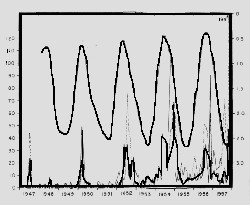
|
Click on image to see larger version
physical activity of certain UFO's (Menzel and Boyd, 1963). In several "good" sightings (those which, for reasons discussed below, do not readily fit any of the remaining four hypotheses), UFO's have appeared to accelerate at tremendous rates or even make right-angle turns while traveling at speeds of several hundred or thousand miles per hour. Although they move in the atmosphere at velocities which surely exceed that of sound, no sonic booms are heard (they are often essentially silent) nor do they appear to burn up with frictional heat. The skeptic says: "Granted that we have a lot left to learn about our universe, we surely don't expect the fundamental laws to be rejected. That we may refine them as Einstein did, it is true, but inertia is inertia, and a right-angle turn at several thousand miles per hour is a simple physical impossibility."
This may be the most compelling argument against the spaceship hypothesis, but there are two counter-arguments. First, one can simply reject the above statement. I do not see how Newton's laws could be so flagrantly violated, but others (Lorenzen, 1962; Michel, 1958; Vallee and Vallee, 1966) have come up with various suggestions. Perhaps inertia is the gravitational interaction between an object and all other objects in the universe. If this gravitational attraction could some way be severed (some mysterious antigravity shield surrounding the spacecraft for example!), then right-angle turns at high speeds might be feasible. Would the surrounding antigravity field also nullify the sound barrier problem? Some think so. I haven't the faintest idea, but we could be wrong about what is impossible. Second, one might remember that not all UFO's perform "impossible" feats. The topic is sufficiently interesting if only one UFO proves to be a spaceship from Mars!
Another argument against the spaceship idea concerns the lack of formal contact with the UFO occupants. Since visiting spaceships ought to be piloted by some sort of intelligent beings, wouldn't it be reasonable to expect that they would desire contact with other intelligent beings, namely us? Or why hasn't a flying saucer landed on the United Nations Building to establish formal diplomatic relations?
This argument assumes that we can understand the motives of an extraterrestrial being. Of course we cannot. How could we know the minds of such beings? To inductively extrapolate from our own current sociological approaches to those of other intelligent entities would be to commit the logical sin of extrapolation in a most flagrant manner. It is easy to imagine several reasons why the extraterrestrials might not want to contact us. Did they plant us here as a colony many thousands of years ago and are carefully observing our evolutionary development? Do they envy us for our natural resources and want to conquer us, although present logistic problems make such an effort impossible? Are they waiting for us to straighten out our wars and race problems? Are they simply uninterested in us as contemporaries, preferring to observe us as specimens? Entomologists study the honeybees very carefully but make no diplomatic contact with the queen!
Imagine the Aborigines of Central Australia, who are still in the Stone Age and who have not even developed the bow and arrow. They have had no contact at all with modern civilization. What happens when a jet plane flies overhead and one of them observes it? When he tells of the huge, shiny bird that didn't flap its wings, had no feet, made an ear-splitting roar, and even had smoke coming out of its tail, surely his fellows assume that he is crazy. Or if the phenomenon becomes so common that it must be accepted as real, they could hardly be expected to deduce from it the conditions of our modern civilization, let alone our motives. "Why," they might ask, "don't the intelligent beings who guide this mighty bird land and trade bone nosepieces with us?" Actually, many of the Aborigines, even those who have come in contact with civilized men, still interpret the airplane in a religious context, as witness the establishment of the cargo cults among these peoples (Worsley, 1959).
We cannot, then, eliminate the spaceship hypothesis, although some of the arguments against it are quite impressive. We should, in deference to the scientific method, examine with a completely open mind any evidence which might be marshalled in favor of the hypothesis. Let us consider the four alternatives to it
Often, the sighting may be placed here with absolute certainty. A balloon reported as a UFO was never out of sight of its launchers. A perplexing light in the sky takes form as an airplane as it gets closer.
Within the last year I have positively identified UFO's over Fort Collins, Colorado (pointed out to me usually by phone) as a weather kite, the planet Venus, and the stars Vega, Capella, Betelguese, and Sirius. Some of the stars close to the horizon flashed red, green, and white, and only a star chart and much discussion could convince the viewer that he was not observing a spaceship.
In many other cases, data are not quite complete enough to be positive, but one can state with a high degree of certainty that a given UFO was quite likely such and such a conventional object or phenomenon.
In the most interesting cases, the sighting seems absolutely to defy explanation in these terms.
One important conclusion becomes apparent: There is a very high noise level in UFO observations. This is exactly what one might expect. People do become excited by news stories and thereby predisposed to such experiences themselves. We cannot, however, from this high noise level write off the entire phenomenon as belonging to this category of conventional objects misinterpreted. Sagan (1963) attempted to do this by pointing out the great diversity which occurs within the sightings. This might well be only the noise. Even if spaceships are visiting us, many people are still seeing conventional objects and interpreting them as spaceships.
The sightings which do not fit well into the conventional-objects-misinterpreted category have certain characteristics concerned primarily with the detail which is observed and with the nature and reliability of the witnesses. Sometimes other evidence is also available.
If only a moving light is seen at a great distance, one can hardly be tempted to run out and meet our big brothers from Mars. Even a disc or a globe with fairly sharp-appearing edges might well be an optical effect of some sort. A report is more impressive when the object is seen at close hand, especially landed on the ground. A very distinct shape with highly distinct edges and a solid, often metallic-appearing surface is described. Windows or other markings may be apparent. Lights are frequently an associated part of the observation, and sometimes (both day and night) the brilliance was said to be so high that the observer found it difficult to continue looking at the UFO. Occasionally, one part of the UFO is described as being in motion relative to other parts, (The rim of a disc may be rotating around the disc.) "Occupants," both humanoid and otherwise, have been reported in conjunction with UFO's, landed and flying. The quality of a sighting is always enhanced when the time of observation is long enough for the observer to consciously consider what he is observing while he is observing it. A light that moves by in less than 5 seconds can hardly produce a very impressive account. In some cases UFO's have been observed for 1 or 2 hours or even longer.
We are primarily concerned with witnesses. Their background and training are especially important, and it is valuable when a single sighting is described by more than one witness. The likelihood of hoax is decreased if the witnesses were unknown to each other before the sighting.
In some cases an account may be supported by various forms of supplementary evidence. There are many cases in which photographs have been taken while a UFO was witnessed by several apparently competent observers. Holes have been left in the ground where a UFO had supposedly landed or vegetation has been damaged or on fire. Occasionally (rarely), radioactivity has been detected. In one case a fence was magnetized where a UFO had passed over it. Many strange samples have been left, such as liquid residues, "angel's hair," and other materials.
In no case, of course, are these things by themselves conclusive, since virtually any sort of evidence could be fraudulently produced. We remain dependent upon the reliability of the witnesses, but sometimes these secondary evidences can contribute to an evaluation of the sighting.
Many radar sightings of UFO's are on file. In a few cases, a UFO has been simultaneously observed by radar and by witnesses, both on the ground and in an aircraft. Menzel and Boyd (1963) have clearly pointed out, however, that radar evidence is far from positive proof. There are many natural atmospheric and other phenomena as well as imperfections in radar instruments which can produce so-called radar angels. We must consider the argument from both sides, however. Just because radar angels are not necessarily UFO's, we are still not entitled to conclude that any unusual blip on the screen is a radar angel. We should certainly not conclude that UFO's cannot be extraterrestrial spaceships, because if they were, our radar net would pick them up. The fact of the matter is, our radar net does pick up many returns which are not identifiable in terms of known aircraft (e.g., apparent objects moving several thousand miles per hour through the atmosphere). Many of these are undoubtedly radar angels in the true sense of the word, but we can't say that some are not spaceships from Mars!
A secondary form of supporting evidence is that of pattern. While Sagan (1963) fails to see any pattern because of the noise, other investigators feel that many patterns can be established from the reports. Figure 1 (UFO's and Mars oppositions) is an example of such a pattern. Various other patterns have also appeared. Michel studied the sightings in France in 1954 and found that occasionally (Fig. 2) they appeared to fall upon great circle arcs of the earth's surface (Michel, 1958). It is extremely difficult (Menzel, 1964; Vallee, 1964) to evaluate the significance of such a pattern. In many cases, the lines could be due purely to chance. In the example illustrated, however, with six points upon a single line, one can't help but be somewhat impressed.
If all of these criteria are met for a given UFO report, then it is highly
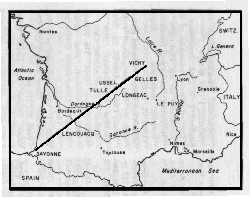
|
Click on image to see larger version
Certainly we do not know all there is to know about the operation of the human mind, so this hypothesis cannot be completely eliminated. And even if the UFO's are spaceships, psychological factors play an important part in the phenomenon. Nevertheless, this hypothesis is not really satisfying. Probably the most detailed study of the UFO's by a psychologist was carried out by Jung (1959). He was able to document a great many extremely fascinating psychological Implications of the UFO. In his final conclusion, however, he could only state that psychological explanations were not sufficient for the phenomenon as a whole.
Before completely eliminating this explanation, we must remember that a hoax can be amazingly effective. I saw the great Blackstone on a stage apparently pass a rapidly moving handsaw blade directly through the neck of an assistant in a trance. A block of wood below the neck was sawed in half amidst much noise and flying sawdust Yet this was admittedly a hoax. Would it be possible to some way cause an illusion in the sky which could completely fool hundreds of witnesses? I cannot absolutely say that it would not. On the other hand, in many cases, producing such an illusion would appear to be almost as great a feat as building a flying saucer itself.
One aspect of the UFO story does seem to be deeply involved in hoax. This is the so-called contactee cult. Many people now located over much of the world claim to have had direct contact with the flying-saucer people. (Adamski and Leslie, 1958; UFO International).
Perhaps the contactee is informed by mental telepathy that he should report promptly to a certain lonely spot in the desert. Upon obeying, he is met by a flying saucer whose occupants are, as a rule, beautifully humanoid and who frequently take him into their confidence by allowing him to photograph themselves and their craft, inviting him in for a look at the control panels, and perhaps taking him for a quick spin, sometimes to Mars or Venus but best of all to the mysterious planet on the other side of the sun, unobservable from mother earth.
Everything about these stories seems to cry hoax. The proof is typically a series of photographs (which could easily be fraudulent) and copious quantities of pseudoscience. Someone who had really contacted visitors from another world should surely be able to do better than that. Why should visitors from another world bother with such obscure representatives of the human race, anyway? Their message is always that man must cease his wars or be destroyed, but why should such an important message be given to someone who is bound to be considered a liar when he delivers it?
It is interesting to consider the possibility that the contactees are genuine. When considering the UFO phenomenon, all sorts of wild alternatives come to mind. If the extraterrestrials wanted to be ignored by the scientific community on earth, they could hardly choose a better and more effective way than the delivering of profound messages to the souls who presently claim contact!
Most convincing is the fact that the UFO phenomenon goes way back into history. UFO enthusiasts, for example, often cite the first two chapters of the Book of Ezekiel in the Old Testament as an excellent example of a flying saucer sighting, (Menzel and Boyd, 1963, indicate that it was probably a sundog, but this is a far-fetched explanation for the details reported by Ezekiel.)
Vallee (1965) documents the sightings previous to 1947. He states that he has on file more than 300 UFO sightings prior to the 20th century, although he apologizes because he has never had the time to make a thorough search. He considers his cases to be only a small sample of those which might be available. They were carefully chosen for their high quality, roughly conforming to the criteria of good sightings described above. Some 60 of these 300 accounts occurred previous to 1800, and the remainder were recorded during the 19th century. The great majority of these more recent accounts were recorded in the scientific literature, particularly that of astronomy (often in the annals of the various astronomical observatories). It is important to emphasize that these are accounts which are not readily explainable as natural phenomena.
Classic, for example, are the observations in Nuremberg (April 14, 1561) and in Basel (August 7, 1566) which have been analyzed in some detail by Jung (1959). Both of these sightings involved large inclined tubes in the sky from which spheres originated, an event occurring sometimes in more recent times (Vallee, 1965, cites 13 examples between 1959 and 1964). Spheres and discs appeared to fight each other in aerial dances. The inhabitants of these two relatively large cities observed this strange phenomenon for a long interval of time on the dates given.
A great attempt was made to consider the scientific accounts of the 19th century in terms of the natural universe. They were referred to as interesting cases of ball lightning or bolide meteors. Nevertheless, the descriptions are of discs and wheels and the like, and the behavior follows very closely that of the modern UFO. These "meteors" would move slowly, appear to hover, change directions, accelerate at great speeds, have an apparent diameter two or three times that of the full moon, etc. In one instance, called ball lightning, an object slowly emerged from the ocean, moved against the wind, hovered close to the ship from which it was observed, and then rushed away in the sky and disappeared in the southeast (for details, see Vallee's book, 1965).
Sightings during the early part of this century were relatively few. The so-called Miracle of Fatima (Vallee, 1965; Walsh, 1947), which took place on October 13, 1917, in a field at Fatima, a small village some 62 miles north of Lisbon, Portugal, is a fascinating tale, to say the least. Today it would be considered a contactee story, since three children were supposedly contacted at monthly intervals (always on the 13th of the month), beginning in May, by a beautiful, "transparent" woman dressed in white, who arrived in a globe of light. Following the first visit, other witnesses besides the children observed strange events (a buzzing noise, etc.), but only the children saw the "vision." At the time of the miracle itself, some 70,000 people were gathered in the field by Fatima to wait for the promised sign. It had been raining when suddenly the "sun" appeared through the dense cloud cover. It was a strange sun, however, looking like a flattened disc with a very definite contour, not appearing as a dazzling object, but rather having a clear, changing brightness which one could compare to a pearl. The disc began turning, rotating with increasing speed as the crowd began to cry with anguish. It then began falling toward the earth "reddish and bloody, threatening to crush everybody under its fiery wake." After an interval of dancing before the crowd, it retreated back through the clouds and disappeared forever. It would be difficult to imagine a sighting which fits the above criteria better than this one. It is also difficult to imagine that the Fatima "sun" was a secret weapon being developed by Russia or the United States!
1. The Arnold Sighting, Mt. Rainier, Washington, June 24, 1947.
Although Vallee (1965) calls our attention to a fascinating wave of sightings in Scandinavia during the summer of 1946, it did not occur to anyone at that time to consider these as extraterrestrial spaceships, but only as secret rockets being developed by Russia or the United States. The current sightings date back to that of Kenneth Arnold. Other better sightings exist for the same period, and even for several days before (as early as April), but Arnold turned his story over to the newspapers, the term "flying saucer" was coined, and the world's attention was focused on the phenomenon.
Arnold saw a formation of silvery discs flying from one peak or ridge to another around Mount Rainier in the state of Washington. By timing the elapsed period from one landmark to another, he was able to estimate their speed at not less than 1,200 miles per hour. Menzel and Boyd (1963) "explain" Arnold's sighting as a mirage brought about by inversion layers in the atmosphere which made the peaks appear to be separated from the mountains below them. Presumably, their apparent motion would be due to the motion of Arnold's airplane. A second explanation proposed by these authors is that Arnold saw the lens-shaped clouds which sometimes occur in the area. They present pictures of such clouds (which look exactly like lens-shaped clouds and not at all like the objects described by Arnold). They further cast aspersions upon Arnold's reliability as a witness by describing in some detail his subsequent actions in attempts to get publicity, etc. Arnold is supported in his story, however, by the fact that it fits perfectly into the pattern of sightings during that period. Various authors (Hall, 1964; Lorenzen, 1962) have summarized these events, and among than a recurring theme is that of formations
It is interesting to wonder about how many apparitions of this type were observed and not reported. My wife's uncle, Mr. Earl Page, then a resident of Kennewick, Washington, had observed on July 12, 1947, a formation of six or eight silvery discs pass by his small airplane at fantastic speed. Mrs. Page and their son were present and saw the objects, which "fluttered as a group for a second or two, and then stabilized ... alternating between these two modes." The Pages were flying north over Utah Lake. Mr. Page told his story to a few friends who laughed at him, and from then on he mentioned it to no one.
Any one of the sittings of formations of saucer-like objects during the summer of 1947 could perhaps be dismissed from the mind. A large number of independent sightings, however, produces a pattern which is quite impressive.
This is one of the best documented sightings on record, involving extremely high speeds and a sharp change of direction (Fig. 3). First Officer William B. Nash and 2nd Officer William H. Fortenberry were flying a commercial plane from New York to Miami, approaching Newport News, Virginia. At 8:12 (just after dark) a brilliant red glow suddenly appeared in the west It was soon resolved as six coin-shaped objects flying in line formation. They glowed with a brilliant orange-red color on top, were estimated to be 100 feet in diameter and 15 feet thick. They moved rapidly toward the plane, at one point breaking slightly in their perfect formation as the second and third objects wavered slightly and almost overran the leader. They turned in unison on edge and reversed position in the formation, the last object moving up to the front position with the others following. They then abruptly reversed direction, moving off somewhat to the right with the original leader again in the lead position. The turn was executed almost like balls bouncing off a wall with no wavering or arc apparent. Two other objects raced out from beneath the plane and took up positions seven and eight in the formation. They decreased in brilliance just before making the
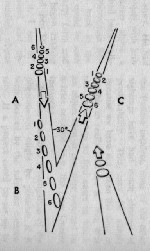
|
Click on image to see larger version
Menzel and Boyd (1963), after considering many possible explanations for the sighting, concluded that the pilots must have seen the illuminated discs produced by a red searchlight shining through nearly transparent thin layers of haze. Charles Maney (1965) corresponded with Menzel for several months, considering all of the possible explanations that might come to mind. Apparently Menzel would have readily accepted several explanations if Maney had not one by one clearly demonstrated their implausibility. The pilots themselves thoroughly rejected Menzel's searchlight hypothesis, saying that they were familiar with such phenomena, and this was simply not what they observed. The details described above are certainly difficult to reconcile with a searchlight hypothesis. The extremely short duration of the sighting, however, makes one question the absolute accuracy of the account. Did some points develop a bit with discussion and remembering? Furthermore, the velocities of the UFO's calculated at Between 6,000 and 12,000 mph through a dense atmosphere at 2,000 feet and including an instantaneous reversal in direction, are, to say the least, extremely difficult to fit into our present concepts of the universe. Light images could perform these maneuvers, but how could they perform some of the other maneuvers reported by the two pilots?
This case is presented as an example of the problems met by a UFO researcher. To solve a sighting such as this to everyone's satisfaction would require turning the clock back.
Figure 4 shows a photograph taken by a Mr. Almiro Barauna, a professional photographer, from the deck of the Almirante Saldanha, a Brazilian Navy ship. Several UFO's had been seen in the vicinity of Trindade Island (a Brazilian possession off the coast of Africa) during its reactivation as a naval base in connection with the International Geophysical Year. In the instance reported here, several sailors at opposite ends of the ship spotted the approaching object simultaneously and began to shout the news to everyone else. Soon the approximately 100 sailors on board, including various officers, were watching the object. Mr. Barauna was preparing to take some photographs and had his camera ready.
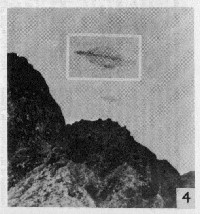
|
Click on image to see larger version
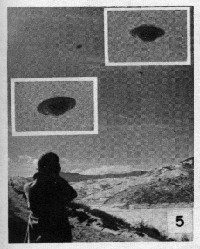
|
Click on image to see larger version
He shot six frames, of which two failed to show the object. He explained that due to the excitement he was bumped during these two and that they showed only the deck of the ship and the ocean. A darkroom was improvised below deck, the film was developed, and the minute object on it was identified by the sailors (Lorenzen, 1962).
This is an excellent sighting because of the number of witnesses involved and the excellent quality of the pictures (especially the third one, the one shown in the figure). Conventional objects can hardly explain the sighting.
Menzel and Boyd (1963) and apparently the United States Air Force consider the sighting to be a hoax. Of the available hypotheses, only this one and that of extraterrestrial machines seem to apply. The hoax explanation must also probably fail if the object was really witnessed by 100 sailors. Menzel and Boyd tell the story differently (their version is based on a report from astronomer friends of Menzel in Rio de Janeiro who did not personally investigate the incident), saying that only Barauna and two or three of his close friends claim to have seen the object. Yet newspaper reporters interviewed the sailors after the Almirante Saldanha landed several weeks later. I have received several reports on the sighting, including a personal conversation with Dr. Olavio Fontes, a medical doctor in Rio de Janeiro who investigated the case exhaustively. These reports fully support the version that virtually all the sailors witnessed the object.
Obviously, our evaluation of the story must hinge upon this aspect The photographs, although extremely convincing, could be fraudulent. To prove this I spent several days in an attempt to duplicate them and succeeded fairly well as indicated in Figure 5. We are still left with the question of the veracity of witnesses.
Driving home from a hunting trip, Mr. and Mrs. Arthur Strauch and their son Gary (age 16), and Mr. and Mrs. Donald Grew, all of Gibbon, Minnesota, sighted a hovering object and got out to observe it. Binoculars were used, and Mr. Strauch took one photograph on an 804 Instamatic Kodak camera using Ektachrome X film. The photograph is shown in Figure 6 along with an artist's conception of the sighting. The object moved toward the witnesses almost directly overhead, making a high-pitched whining sound and traveling at very high speed. It disappeared in the southeast within seconds.
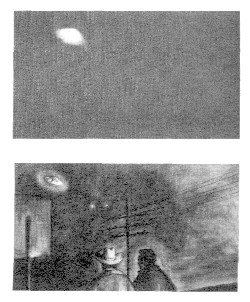
|
Click on image to see larger version
Patrolman Lonnie Zamora was following a speeder when he saw a blue flame to the southwest. He recognized the area as one which contained a dynamite shack and where teenagers sometimes tried to accelerate their cars up the steep slopes. He decided to investigate. Driving over a mesa (Fig. 7), he caught sight of something which he interpreted as an automobile standing on end with two children or small adults dressed in white clothing and standing by it. He radioed Patrolman Sam Chavez, asking for assistance, and continued down through a gully where he lost sight of the object. Coming up across the next mesa, he parked and got out of his car, moving toward the gully to see the object. It was immediately apparent that he was not observing an automobile wreck. There was a hemispherical object standing on four legs and suddenly an ear-splitting roar. Thoroughly frightened, he turned and ran, collided with the hood of his car, and then threw himself on the ground, noticing again that the object was rising in a slanting trajectory toward the southwest. As it rose, it displayed a blue flame.
Upon investigation of the site, four distinct, rather deep impressions were found in the ground where Zamora claims to have seen the landing gear. Two smaller round depressions were in the place where a ladder was placed, leading to a marking on the object which could have been a door. Bushes below where the object had been were burning. Detailed investigations were carried out by the Air Force and by several private flying saucer investigating groups.
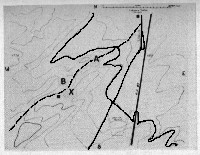
|
Click on image to see larger version
Sightings were similar on both evenings. On the evening of the 27th, Father W. B. Gill, a teacher and missionary of the Anglican Church in New Guinea, came out of the dining hall at. 6:45 p.m., looked up and saw Venus and then the large sparkling object. While he watched, some 39 others joined him (five were teachers, two were medical assistants, the rest were natives; 28 adult witnesses signed a statement). The object and two others that hovered at a greater distance are shown in the figure (see p. 15) as an artist's conception (the witnesses had no cameras but made pencil sketches during the observation). As the UFO hovered nearby, Man-shaped forms appeared on the "Top Deck" and seemed to be working on something. Occasionally, there was a bright blue, thin beam of light which projected toward the sky. The object itself had an orangeish cast, and the "men" appeared to be dressed in silver suits of some kind. The most seen at one time were four. When one of the figures appeared to glance over the crowd. Gill waved his arm, and the figure returned the gesture. Gill and some of the natives then raised both arms, and two of the figures on the object did the same. The object came lower but did not land. The sighting lasted until 7:20 when the blue spotlight went out and the object moved into a cloud.

|
Click on image to see larger version
A remarkable sighting occurred rather recently in New Hampshire and was studied and documented by several UFO investigators but particularly by Mr. John G. Fuller, a columnist for the Saturday Review. He has assembled his results into book form (Fuller, 1966), and a preliminary account was published in Look Magazine (February 22, 1966). The sightings are remarkable not only because of their nature but in a very real sense because of Mr. Fuller's investigation.
The basic sightings occurred in the early morning hours (about 2:00 a.m. to 4:00 a.m.). Patrolman Eugene Bertrand of Exeter had checked on a parked car and found a woman who told him that a huge and silent airborne object had trailed her from the town of Epping 9 miles away. The object had brilliant flashing red lights and kept within a few feet of her car. Developing tremendous speed, it had disappeared among the stars. The patrolman could not believe the story and had not even taken the woman's name.
When Bertrand checked into the police station, Norman Muscarello had just arrived and told his story. He had also seen a large dark object with brilliantly flashing lights hover above a field through which he had been walking on his way home. Patrolman Bertrand accompanied him back to the scene. Although nothing could be seen at first, horses on a nearby farm and dogs in nearby houses began making a great deal of noise, and then Muscarello screamed, "I see it, I see it!" Patrolroan Bertrand turned and observed the brilliant roundish object moving toward them like a leaf fluttering from a tree. Its red lights along the sides were so brilliant that the entire area was bathed in light. It came within about 100 feet of the two witnesses, hovering with a rocking motion, absolutely silent. The lights seemed to be dimming or pulsating from left to right and then from right to left, taking about 2 seconds for each cycle. The lights were so brilliant that it was difficult to make out the shape of the object itself. It darted, turned rapidly, slowed down, and performed other such maneuvers.
Patrolman David Hunt had heard the radio conversation between Bertrand and the station in Exeter and drove to the site, witnessing the object for a few minutes before it disappeared, A B-47 flew over shortly after, providing an extreme contrast to the object which they had previously witnessed.
In Fuller's study of the case, he was able to find some 60 different people who had witnessed similar objects over a period of several days or weeks in the fall of 1965. Muscarello was so impressed by his sighting that he and his mother waited on a mountainside nearly every evening for 3 weeks following the event. On one of these evenings, they again witnessed the object. Other people in the area would park by high tension lines (in the Exeter sightings, the objects were frequently associated with power lines) and watch for the objects, occasionally being rewarded with the sight of one.
This sighting is not only a good one because of the detail, the number of witnesses, and the several occasions involving comfortable intervals of time, but it adds one other extremely encouraging note. If Muscarello and other New Hampshire residents could go out and watch for the objects, occasionally being able to see them, why couldn't properly equipped scientific investigators do the same? Except for the Fatima incident, none of the other sightings have had much element of predictability. This may be simply because we have not taken the time or trouble to really look for it. Yet, it is not uncommon to find cases in which an object seen at one time returned on a later occasion (e.g., the New Guinea instance).
Serious scientific investigation of the phenomenon might be possible if it were desired by the scientific community. If a project could be set up by a number of scientists, it might be feasible to have everything in readiness for another wave of sightings such as that at Exeter or the subsequent one in the Michigan swamps. When such a wave appeared (and the proper kind of publicity might help in detecting it -- although it could also contribute to the generation of a wave of fraudulent sightings), the team of researchers might converge immediately upon the area and carry out some sort of previously planned program of investigation. If the investigators themselves were too
Fuller, John G. 1966. Incident at Exeter. Putnam & Sons, New York.
Hall, Richard H. (ed.). 1964. The UFO Evidence. National Investigations Committee on Aerial Phenomena, Washington, D.C. 184 pp.
Hynek, J. Allen. 1966. UFO's merit scientific study. Science, 154: 329.
Jackson, F., and P. Moore. 1965. Possibilities of life on Mars. In Current Aspects of Exobiology, G. Mamikunian and M. H. Briggs (eds.). Pergamon Press, Inc., London, New York, Germany. Chapter 5.
Jung, C. G. 1959. Flying Saucers. Routledge & Kegan Paul Ltd., London. 184 pp.
Keyhoe, Donald E. 1960. Flying Saucers Top Secret. Putnam Publishing Co., Longmans. Toronto. 283 PP.
Klass, Philip L 1966. Many UFO's are identified as plasmas. Aviation Week Space Technology, Oct. 3. p. 54.
Ley, Willy, and Wernher Von Braun. 1960. The Exploration of Mars. The Viking Press, New York. 176 pp.
Lorenzen, Carol E. 1962. The Great Flying Saucer Hoax. The William-Frederick Press, New York. 257 pp.
Lorenzen, Carol E. 1966. Flying Saucers. Signet Books, New York. 278 pp.
Maney, Charles A. 1965. Donald Menzel and the Newport News UFO. Fate Magazine, pp. 64-75 (April).
Menzel, Donald H. 1964. Global orthoteny, new pitfalls. Flying Saucer Review, pp. 3-4 (Sept., Oct.).
Menzel, Donald H., and Lyle G. Boyd. 1963. The World of Flying Saucers. Doubleday & Company, Inc., Garden City, N.Y. 302 pp.
Michel, Aime. 1958. Flying Saucers and the Straight-Line Mystery. Criterion Books, New York. 285 pp.
Sagan, C. 1963. Unidentified flying objects. The Encyclopedia Americana.
Salisbury, F. B. 1962. Martian biology. Science, 136: 17-26.
Salisbury, F. B. 1964. Das Mars Paradoxon. Naturwissenschaft und Medizin, 1 (5): 36-50.
Salisbury, F. B. 1966. Possibilities of Life on Mars. Proceedings of the Conference on the Exploration of Mars and Venus, Virginia Polytechnic Institute, Blacksburg, Va., August 1965. VI: 1-16.
UFO international. Published periodically by the Amalgamated Flying Saucer Clubs of America, Inc. International Headquarters: 2004 N. Hoover St., Los Angeles, Calif.
Vallee, Jacques. 1964. The Menzel-Michel controversy, some further thoughts. Flying Saucer Review, pp. 4-6 (Sept., Oct.).
Vallee, J. 1965. Anatomy of a Phenomenon. Henry Regnery Co., Chicago, Ill., 210 pp.
Vallee, Jacques, and Janine Vallee. 1962. Mars and the flying saucers. Flying Saucer Review, pp. 5-11 (Sept., Oct.).
Vallee, Jacques, and Janine Vallie, 1966. Les Phenomenes Insolites de L'Espace, La Table Ronde, Paris. 321 pp.
Walsh, Wm. Thomas. 1947. Our Lady of Fatima. MacMillan Co., New York. 228 pp.
Worsley, Peter M. 1959. Cargo cults. Scientific American 200: 117-128.